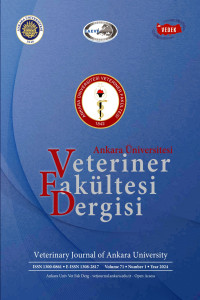Near-infrared light transillumination for occlusal caries detection in dog teeth: A comparative study
Abstract
The aim of this study is to compare the effectiveness of visual, radiologic, and near-infrared light transillumination caries detection methods on caries of dog teeth in-vitro. A total of 237 dog molar teeth were evaluated with three different methods; visio-tactile examination with a probe, radiographic assessment, and NIR-LT. Each tooth was evaluated with all of the methods; the absence or presence of occlusal caries was scored as either 0, caries not present, or 1, caries present. All caries detection methods yielded the same outcomes for each tooth. Among all caries detection methods positive Spearman’s rho value (ϱ=1) indicated that there was a strong positive correlation between the caries detection methods. Since NIR-LT is such a comfortable and easy caries diagnosis method, it can be used without sedation, especially in calm dogs.
Ethical Statement
No examination, research, manipulation or experimentation was performed on any animal species during this study.
References
- Abdelaziz M, Krejci I, Perneger T, et al (2018): Near infrared transillumination compared with radiography to detect and monitor proximal caries: A clinical retrospective study. J Dent, 70, 40-45.
- Bell A (1965): Dental disease in the dog. JSAP, 6, 421-428.
- Hale FA (1998): Dental caries in the dog. JOVD, 15, 79-83.
- Hale FA (2009): Dental caries in the dog. Can Vet J, 50, 1301-1304.
- Hamp SE, Olsson SE, Farsø‐Madsen K, et al (1984): A macroscopic and radiologic investigation of dental diseases of the dog. Vet Radiol Ultrasound, 25, 86-92.
- Kühnisch J, Söchtig F, Pitchika V, et al (2016): In vivo validation of near-infrared light transillumination for interproximal dentin caries detection. Clin Oral Investig, 20, 821-829.
- Schwendicke F, Elhennawy K, Paris S, et al (2020): Deep learning for caries lesion detection in near-infrared light transillumination images: A pilot study. J Dent, 92, 103260.
- Söchtig F, Hickel R, Kühnisch J (2014): Caries detection and diagnostics with near-infrared light transillumination: clinical experiences. Quintessence Int, 45, 531-538.
- Tassoker M, Ozcan S, Karabekiroglu S (2020): Occlusal Caries Detection and Diagnosis Using Visual ICDAS Criteria, Laser Fluorescence Measurements, and Near-Infrared Light Transillumination Images. Med Princ and Pract, 29, 25-31.
- Zakian CM, Pretty IA, Ellwood R (2009): Near-infared hyperspectral imaging of teeth for dental caries detection. J Biomed Opt, 14, 064047.
- Zandoná AF, Zero DT (2006): Diagnostic tools for early caries detection. J Am Dent Assoc, 137, 1675-1684.
- Zero DT (1999): Dental caries process. Dent Clin N Am, 43, 635-664.
Abstract
References
- Abdelaziz M, Krejci I, Perneger T, et al (2018): Near infrared transillumination compared with radiography to detect and monitor proximal caries: A clinical retrospective study. J Dent, 70, 40-45.
- Bell A (1965): Dental disease in the dog. JSAP, 6, 421-428.
- Hale FA (1998): Dental caries in the dog. JOVD, 15, 79-83.
- Hale FA (2009): Dental caries in the dog. Can Vet J, 50, 1301-1304.
- Hamp SE, Olsson SE, Farsø‐Madsen K, et al (1984): A macroscopic and radiologic investigation of dental diseases of the dog. Vet Radiol Ultrasound, 25, 86-92.
- Kühnisch J, Söchtig F, Pitchika V, et al (2016): In vivo validation of near-infrared light transillumination for interproximal dentin caries detection. Clin Oral Investig, 20, 821-829.
- Schwendicke F, Elhennawy K, Paris S, et al (2020): Deep learning for caries lesion detection in near-infrared light transillumination images: A pilot study. J Dent, 92, 103260.
- Söchtig F, Hickel R, Kühnisch J (2014): Caries detection and diagnostics with near-infrared light transillumination: clinical experiences. Quintessence Int, 45, 531-538.
- Tassoker M, Ozcan S, Karabekiroglu S (2020): Occlusal Caries Detection and Diagnosis Using Visual ICDAS Criteria, Laser Fluorescence Measurements, and Near-Infrared Light Transillumination Images. Med Princ and Pract, 29, 25-31.
- Zakian CM, Pretty IA, Ellwood R (2009): Near-infared hyperspectral imaging of teeth for dental caries detection. J Biomed Opt, 14, 064047.
- Zandoná AF, Zero DT (2006): Diagnostic tools for early caries detection. J Am Dent Assoc, 137, 1675-1684.
- Zero DT (1999): Dental caries process. Dent Clin N Am, 43, 635-664.
Details
| Primary Language | English |
|---|---|
| Subjects | Veterinary Anatomy and Physiology, Veterinary Sciences (Other) |
| Journal Section | Research Article |
| Authors | |
| Publication Date | January 2, 2024 |
| Published in Issue | Year 2024 Volume: 71 Issue: 1 |

